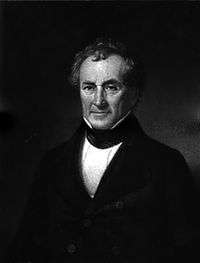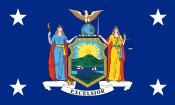James Tallmadge, Jr.
| James Tallmadge Jr. | |
|---|---|
 | |
| Lieutenant Governor of New York | |
|
In office 1825–1826 | |
| Governor | DeWitt Clinton |
| Preceded by | Erastus Root |
| Succeeded by | Nathaniel Pitcher |
| Member of the U.S. House of Representatives from New York's 4th district | |
|
In office June 6, 1817 – March 3, 1819 | |
| Preceded by | Abraham H. Schenck |
| Succeeded by | Randall S. Street |
| Personal details | |
| Born |
January 28, 1778 Stanford, New York |
| Died |
September 29, 1853 (aged 75) New York City, New York |
| Political party | Democratic-Republican |
| Signature |
|
James Tallmadge, Jr. (January 28, 1778 – September 29, 1853) was a United States lawyer, and politician.
He was a United States Representative from New York's 4th congressional district.
Biography
Born in Stanford, Dutchess County, New York, his father, Colonel James Tallmadge (1744-1821), led a company of volunteers at the capture of General John Burgoyne.
He graduated from Brown University, Providence, Rhode Island in 1798, and was secretary to New York Governor George Clinton from 1798 to 1800. He studied law and was admitted to the bar in 1802, after which he practiced in Poughkeepsie and in New York City. He was Surrogate of Dutchess County from 1804 to 1810.
He served in the War of 1812 and commanded a company of home guards in defense of New York.
Term in Congress
Representative-elect Henry B. Lee died on February 18, 1817. In the special election to replace him, Tallmadge was elected as a Democratic-Republican to the Fifteenth Congress. He served from June 6, 1817, to March 3, 1819. In the House he defended General Andrew Jackson's course in the Seminole War.
His most famous action in Congress was the Tallmadge Amendment to the bill for Missouri statehood. It would have restricted slavery in Missouri and provided for its future termination. It read as follows:
"And provided, That the further introduction of slavery or involuntary servitude be prohibited, except for the punishment of crimes, whereof the party shall have been fully convicted; and that all children born within the said State, after the admission thereof into the Union, shall be free at the age of twenty-five years."[1]
In support of this amendment, on February 16, 1819, he delivered a powerful speech in opposition to the extension of slavery.[2] This speech was widely circulated, and was translated into German.
The House adopted the Tallmadge Amendment, but the Senate rejected it.
Later career
Tallmadge declined to run for a second term in the House. He continued the practice of law in New York City, and took a prominent role in civic affairs.
He was a delegate to the Constitutional Convention of 1821, a member of the New York State Assembly in 1824, and Lieutenant Governor of New York from 1825 to 1826.
He assisted in the founding of New York University in 1831. The University conferred an honorary LL.D. on him in 1838.
He was also one of the founders of the American Institute, a New York society for the promotion of inventions and technical education, and was its president from 1831 to 1850.
In 1836 he visited Russia, and helped introduce into that country several American mechanical inventions, especially cotton-spinning machinery.
He was a delegate to the Constitutional Convention of 1846.
Family
His only daughter was regarded as one of the most beautiful women in the country, and accompanied her father to Russia. She married Philip S. Van Rensselaer, third son of Stephen Van Rensselaer III, the last patroon of the Manor of Rensselaerswyck. Their only surviving son, James Tallmadge Van Rensselaer, was a well-known lawyer in New York City.
Death
Tallmadge died on September 29, 1853 in New York City. He is buried at the New York Marble Cemetery.
See also
References
- United States Congress. "James Tallmadge, Jr. (id: T000031)". Biographical Directory of the United States Congress.
- Political Graveyard
- Biographical Directory
| United States House of Representatives | ||
|---|---|---|
| Preceded by Abraham H. Schenck |
Member of the U.S. House of Representatives from New York's 4th congressional district June 6, 1817 – March 3, 1819 |
Succeeded by Randall S. Street |
| Political offices | ||
| Preceded by Erastus Root |
Lieutenant Governor of New York 1825–1826 |
Succeeded by Nathaniel Pitcher |
